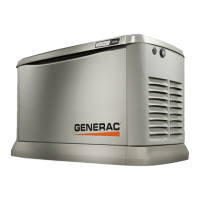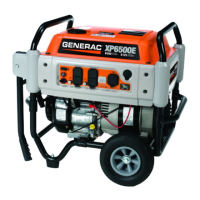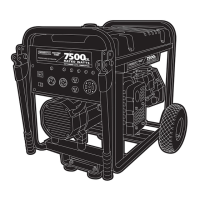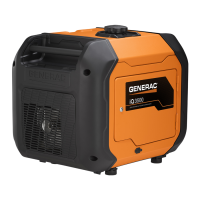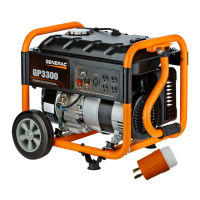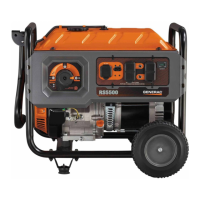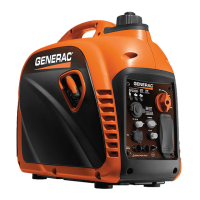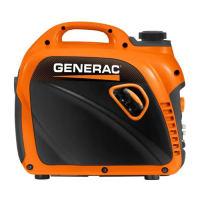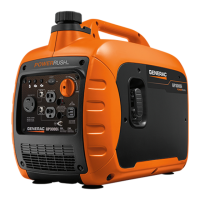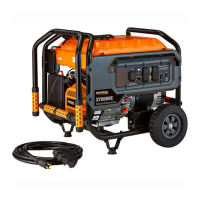Electrical Connections
Installation Guidelines For 60 Hz EcoGen™ Generators 31
Main AC Wiring
NOTE: Main AC wiring must be in accordance with local
jurisdiction and codes.
NOTE: Generator lugs are rated at 167 °F (75 °C), cop-
per or aluminum.
1. Strip insulation off wire ends. Do not remove
excessive insulation.
2. See Figure 6-1. Loosen lugs at neutral (D), ground
(G), and power wire (mains) terminals (E1, E2).
3. Connect ground wire to ground lug and tighten to
required specification. See Table 6-4.
4. Connect neutral wire to neutral lug if applicable.
Tighten to required specification. See Table 6-4.
5. Insert power wires (E1 and E2) into corresponding
lugs. Tighten to required specification.
6. Verify factory-installed ground array and neutral
connections are correctly tightened to 25 in-lb
(2.82 Nm).
NOTE: Neutral wire must remain connected to keep bat-
tery charged whether generator is running or not.
NOTE: Neutral bonding – For installations requiring neu-
tral to be bonded to ground, this is done on the customer
connections terminals inside generator.
See Figure 6-1. Connect a suitably sized system bond-
ing jumper in accordance with NEC Table 250.102(C)(1)
from neutral bar (J) to ground stud (F). Tighten ground
stud nut to 35 in-lbs (3.95 Nm). This is required when
generator is installed as a separately derived system.
Generator will also require a connection to a grounding
electrode system in accordance with NEC Article 250.64.
It is not required when generator is a backup source in a
utility supplied electrical system with a 2-pole transfer
switch. Installation must be made in accordance with
NEC Articles 250.30 and 250.35(A) if generator will be
installed as a separately derived system.
NOTE: 120V loads can be connected across either E1
to Neutral or E2 to Neutral. If running in this 120V config-
uration, limit load across either connection to 50% of
rated load to prevent damage to wires or main line circuit
breaker.
NOTE: Tighten all wiring lugs, bus bars, and connection
points to required torque specifications.
Conductors of AC and DC circuits, rated 1000 volts nom-
inal or less, shall be permitted to occupy the same equip-
ment, cable, or conduit. All conductors shall have an
insulation rating equal to at least the maximum circuit
voltage applied to any conductor within the equipment,
cable, or conduit. See NEC 300.3(C)(1).
Service Entrance Decals
See Figure 2-7. Locate service entrance-related decals
in the loose parts bag.
• Place service disconnect decal next to main line
circuit breaker (generator disconnect) (if required
by local code).
• Place service entrance warning decal in an appro-
priate location according to instructions printed on
decal.
Common Alarm Relay (Option)
Alarms relating to generator and engine performance
appear on the controller and in the Mobile Link
®
applica-
tion (if used). The controller is equipped with a common
alarm relay providing contacts for an optional customer-
supplied external alarm indicator.
The common alarm relay is normally open until an alarm
occurs, triggering relay to close contacts.
Terminals for the common alarm relay are provided in the
wiring harness near the controller plug (Wires 209 and
210).
Contact rating is for resistive load only:
Table 6-4. Ground and Neutral Connections
(Copper or Aluminum Conductors)
See national and/or local codes to verify correct wire sizes.
No. Description
Recommended
Wire Size
Torque Spec
1
Power wire
terminals
2/0 to 8 AWG 120 in-lb (13.56 Nm)
2
Large neutral
lug
2/0 to 14 AWG 120 in-lb (13.56 Nm)
3 Large ground lug 2/0 to 14 AWG 120 in-lb (13.56 Nm)
4 Neutral bus bar
4-6 AWG
8 AWG
10-14 AWG
35 in-lb (3.95 Nm)
25 in-lb (2.82 Nm)
20 in-lb (2.26 Nm)
Table 6-5. Remote Start Connections
Wire Connection
Location
178
Mated Fastons
Two-Wire Start
Hanging from controller above battery
compartment
183
Mated Fastons
Two-Wire Start
Contact rating 200 mA at 12 VDC
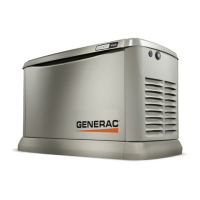
